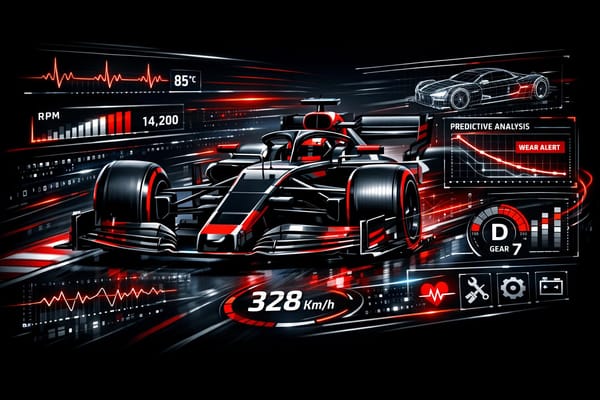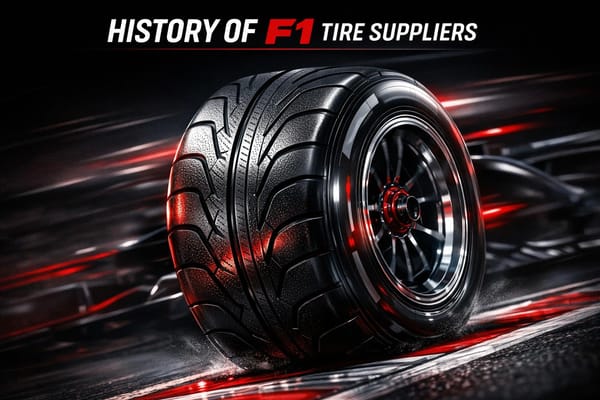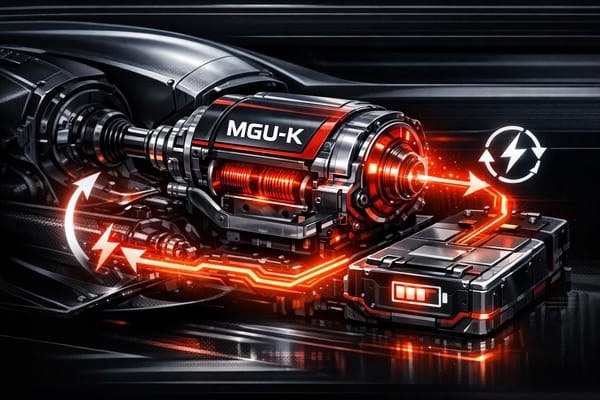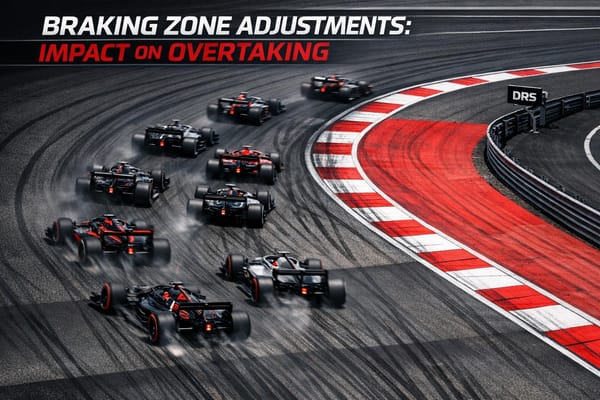5 Iconic F1 Tracks You Must Visit for the Ultimate Racing Experience
Explore five iconic Formula 1 tracks that deliver unforgettable racing experiences, blending history, design, and passionate fan culture.
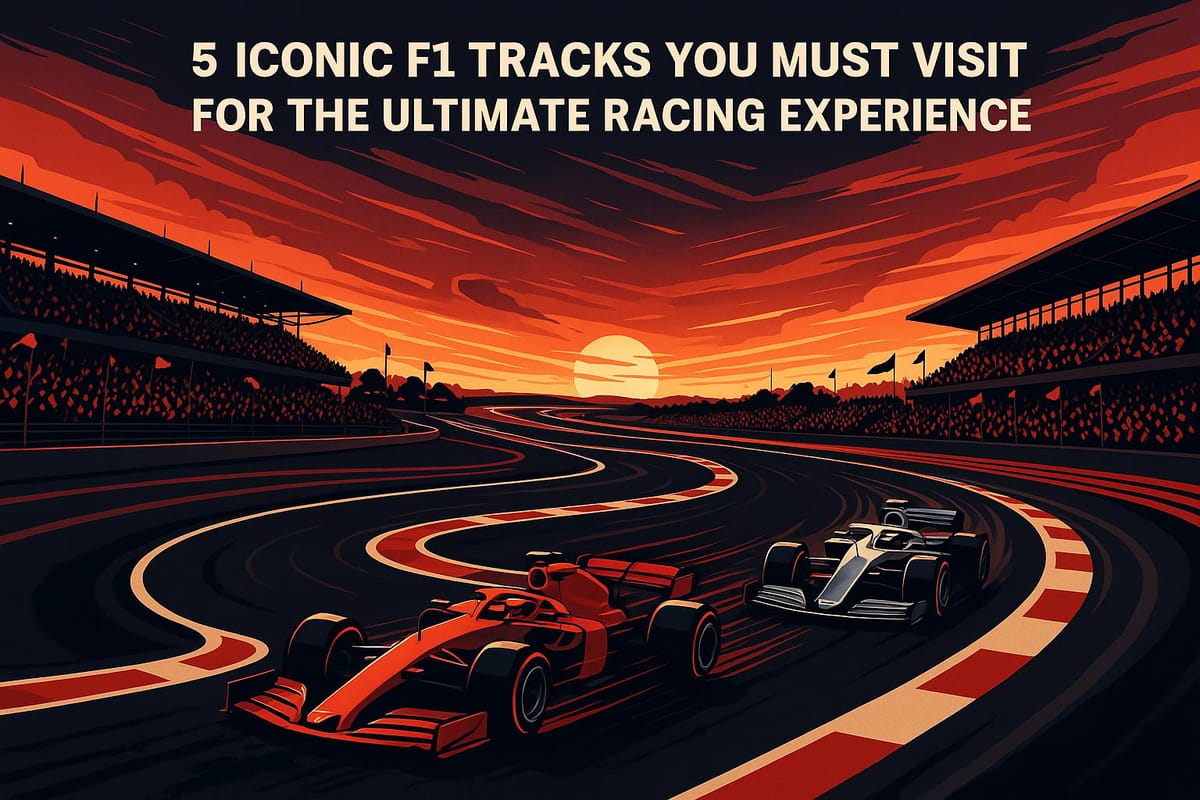
Formula 1 circuits are more than just race tracks - they’re where history is made, and fan culture thrives. From high-speed straights to challenging corners, these tracks offer unforgettable experiences. Here’s a quick look at five must-visit F1 circuits:
- Monza (Italy): The "Temple of Speed" with its long straights and passionate Italian fans.
- Monaco (Monte Carlo): A glamorous street circuit with tight corners and luxury-filled surroundings.
- Silverstone (UK): The birthplace of modern F1, known for its fast, flowing layout.
- Spa-Francorchamps (Belgium): Features dramatic elevation changes and the legendary Eau Rouge corner.
- Suzuka (Japan): Famous for its figure-eight design and pivotal championship moments.
Each track brings its own blend of history, design, and fan energy, making them bucket-list destinations for any F1 enthusiast. Below, we explore what makes these circuits stand out.
Top 10 Legendary F1 Tracks You Have to Experience
1. Autodromo Nazionale Monza
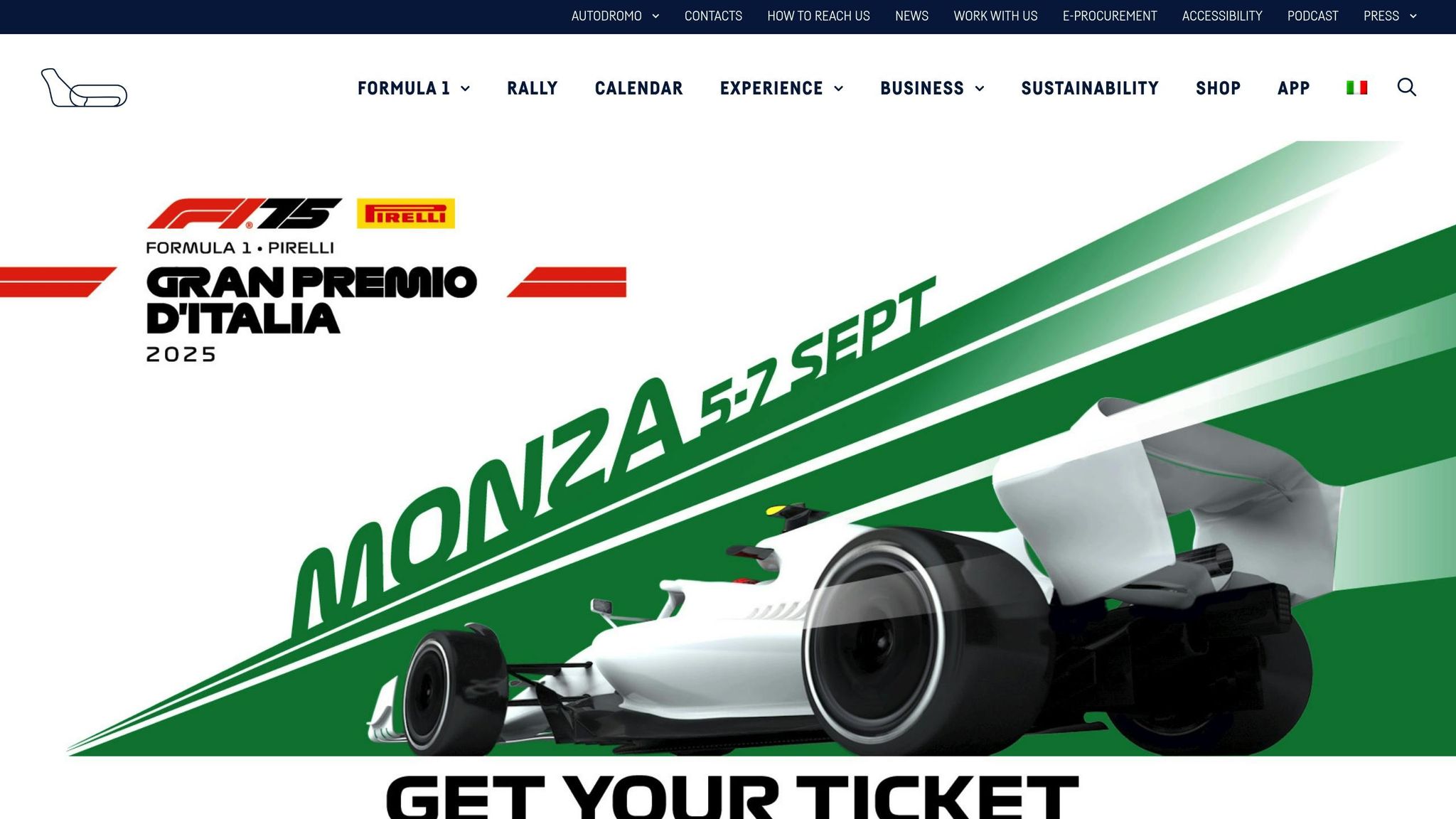
Nicknamed the "Temple of Speed", Monza is one of Formula 1's most legendary circuits. Nestled in Italy, it combines blistering speed with a rich racing heritage.
Historical Significance
Completed in just 110 days back in 1922, Monza holds the distinction of being the third-oldest purpose-built motor racing circuit in the world and the oldest on mainland Europe. It became a cornerstone of Formula 1 by being part of the inaugural 1950 calendar and has hosted the Italian Grand Prix since 1949. Monza's legacy is intertwined with Alfa Romeo, and over the decades, it has been a stage for technological milestones and unforgettable moments that have shaped the sport.
Track Layout Features
Monza's design is all about speed. With its long straights and fast corners, cars spend about 80% of each lap at full throttle. In fact, Juan Pablo Montoya set an eye-popping average of 162 mph (260.6 km/h) during a 2004 practice session, a testament to the circuit's high-speed reputation. Though safety upgrades have been made over the years, the track has managed to retain its adrenaline-pumping character.
Spectator Amenities
Monza goes the extra mile to ensure fans have an unforgettable experience. The venue boasts a vibrant fan zone featuring DJ sets, driver meet-and-greets, simulators, interactive exhibits, and official merchandise. Food options are reasonably priced, and fans can also bring their own meals and drinks, as long as they avoid glass containers, cans, and alcohol. Free water stations are scattered throughout the circuit, offering a welcome respite during hot race days.
The "Monza Circuit" app is a handy tool for visitors, offering maps, walking directions, points of interest, and event schedules. This is especially helpful given the circuit's sprawling layout. After addressing feedback from 2022, Monza has improved its visitor experience by scrapping a token payment system, adding more water stations, enhancing security, and expanding the fan zone.
Atmosphere and Fan Experience
Monza's atmosphere is electric, driven by the fervor of Italian fans who treat race weekends like a festival. The circuit is set within a sprawling 1,700-acre (688-hectare) city park, adding a scenic backdrop to the high-octane action. A cherished tradition is the post-race track invasion, where fans flood the circuit to celebrate and gather beneath the podium - a moment that stays with attendees forever.
To make the most of your visit, come prepared. Bring sunscreen, a hat, and comfortable shoes to navigate the extensive walking and limited shade. Arrive early to grab a prime viewing spot, and don’t wait to buy merchandise - it sells out fast. Monza’s vibrant atmosphere and passionate crowd make it an unforgettable stop in the Formula 1 calendar.
2. Circuit de Monaco
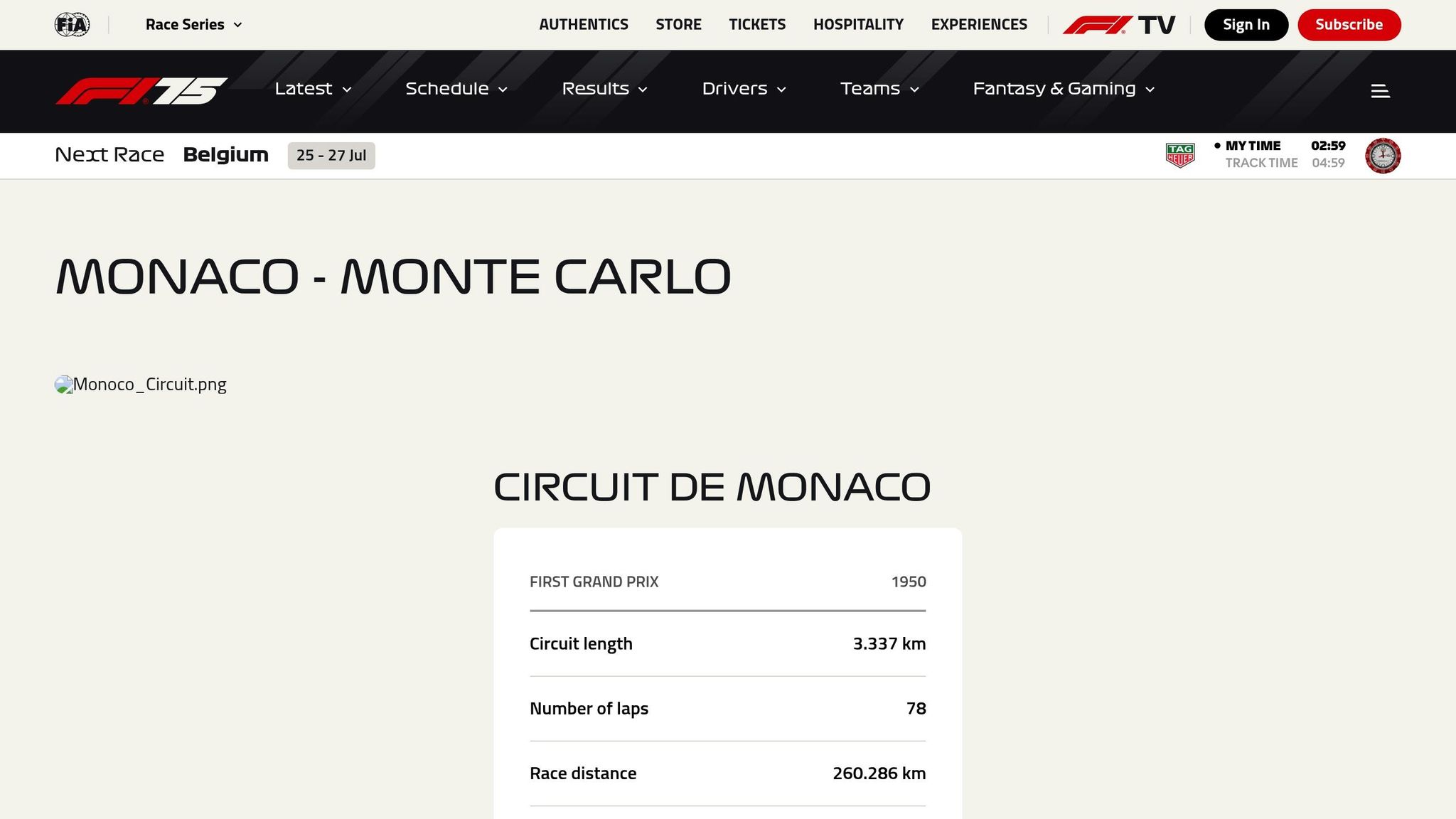
The Monaco Grand Prix is the crown jewel of Formula 1, blending thrilling racing with the glitz and glamour of Monte Carlo. Picture narrow streets, luxury yachts, and casino terraces - this race offers an experience like no other.
Historical Significance
Monaco stands out as one of Formula 1's most iconic street circuits. Since becoming part of the World Championship in 1950, it has earned its place as a cornerstone of the sport. What makes Monaco truly special is its exclusivity - fewer than 40,000 grandstand seats are available each year, making tickets a prized commodity.
"Winning the Monaco Grand Prix is the highlight of any racing driver's career." - Nico Rosberg
This sense of rarity extends to every aspect of the event, from its challenging track design to its luxurious spectator offerings.
Track Layout Features
Monaco's circuit is a masterpiece of street racing, weaving through some of the principality's most famous landmarks. Drivers navigate Casino Square, tackle the tight Fairmont Hotel Hairpin, and face the precision-demanding Swimming Pool Complex. The track's narrow, winding streets leave no room for error, demanding absolute focus and skill from even the most seasoned racers.
Spectator Amenities
Monaco caters to a wide range of spectators, offering options from standard grandstand seating to extravagant VIP experiences. Grandstand tickets start at €275, while luxury packages, including superyacht views, can exceed £15,000. Popular seating areas include:
- Grandstand A1 at Sainte Devote: Perfect for Turn 1 action.
- Grandstand B at Casino Square: Offers a stunning view of the Monte Carlo Casino backdrop.
- Grandstands L to P at the Swimming Pool Complex: Provides thrilling close-up views of the action.
For those seeking the ultimate indulgence, hospitality packages include options like the Michelin-starred Yoshi Restaurant package, the Ermanno Palace suite with panoramic race views, and the La Rascasse package, which combines race-day luxury with access to the legendary afterparty.
Atmosphere and Fan Experience
During the Grand Prix, Monaco transforms into a playground for the elite. The event combines adrenaline-pumping racing with an air of sophistication, enhanced by trackside hotels, fine dining, and breathtaking views.
Given the high demand, it’s wise to book accommodations and tickets as early as possible. Navigating the compact principality is made easier with helicopter or limousine transfers. On race day, smart casual attire is recommended - some venues may require jackets or cocktail dresses. Essentials like earplugs, sunglasses, a hat, and sunscreen will ensure a comfortable experience.
The Monaco Grand Prix isn’t just a race; it’s an invitation to immerse yourself in a world of high-speed action and unparalleled luxury. For any Formula 1 fan, it’s a bucket-list event that perfectly combines the thrill of competition with the allure of high society.
3. Silverstone Circuit
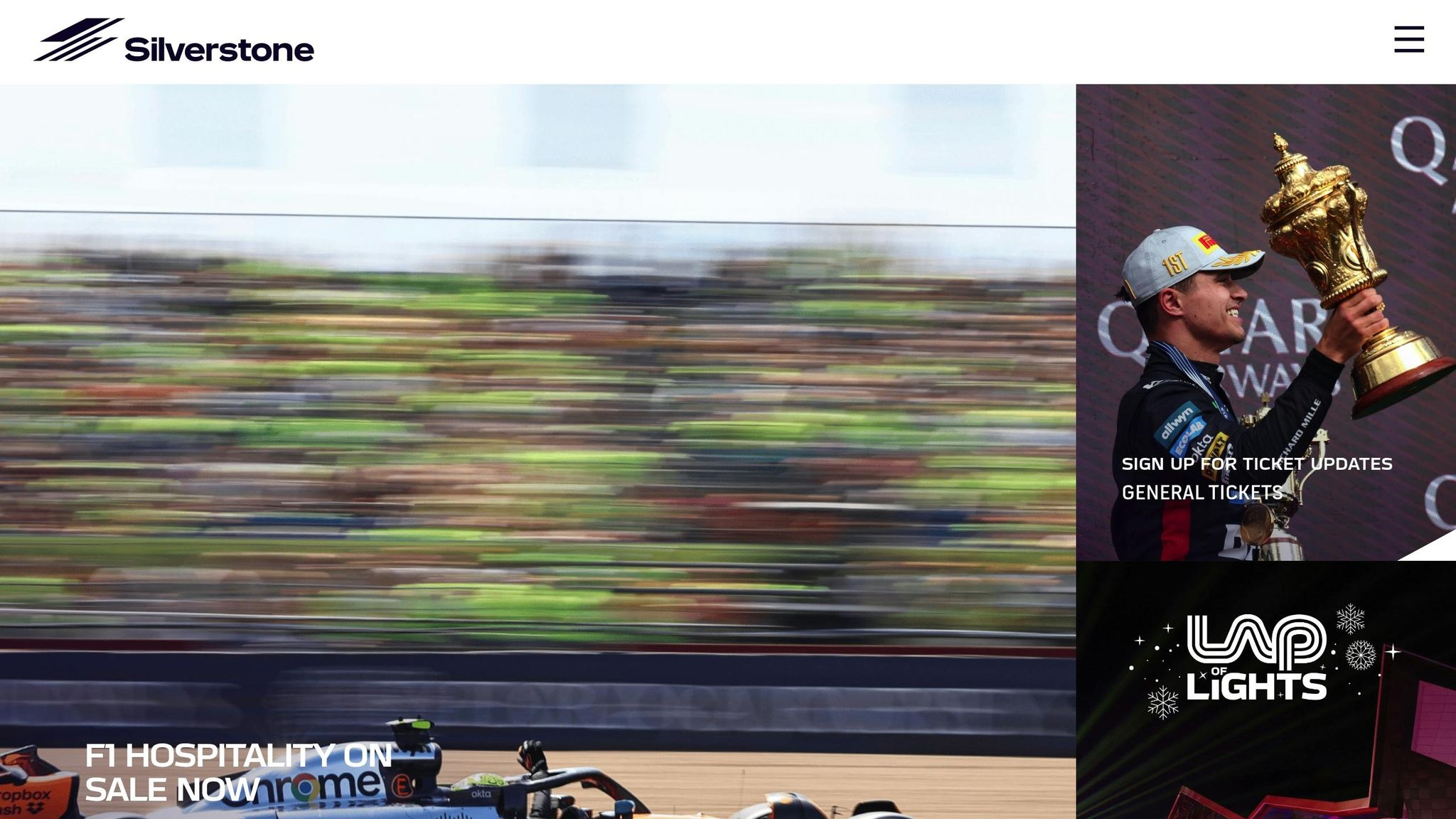
Silverstone Circuit offers a perfect mix of adrenaline-pumping speed and technical challenges, making it a favorite among drivers and fans. Its rich history, cutting-edge design, and modern facilities contribute to its legendary status in motorsport.
Historical Significance
One pivotal moment in Silverstone’s history was the introduction of the Arena layout in 2010. This redesign improved overtaking opportunities and elevated the race-day experience for both drivers and spectators.
Track Layout Features
Spanning 3.660 miles (5.891 km) and featuring 18 demanding corners, Silverstone pushes drivers to their limits. With speeds exceeding 198 mph (320 km/h), the track combines high-speed straights with intricate turns. Iconic sections like Copse, Maggots, and Becketts test both precision and endurance, delivering intense g-force moments.
"Silverstone is another drivers' favorite with fast, flowing sequences and some of the best corners in the world. Copse, Maggots and Becketts are where you feel g-force on your body that is pretty rare in Formula 1."
– Jolyon Palmer, former Renault F1 driver
This carefully crafted layout emphasizes fast, flowing sections, allowing drivers to showcase their skills while delivering an unforgettable experience for spectators.
Spectator Amenities
Silverstone ensures fans have a top-tier experience. The venue operates cashless and boasts over 250 food and drink options to suit various tastes. Dedicated apps provide real-time updates, ticketing, and navigation assistance, while charging stations are conveniently located around the circuit.
For merchandise lovers, the Castore Megastore offers official team gear, while fan zones feature interactive attractions like racing simulators, pitstop challenges, and driver reaction tests. Families can enjoy kid-friendly areas with workshops and games, while the Silverstone Interactive Museum dives into British motorsport history. Hospitality packages cater to all needs, ranging from standard access to premium options like the Champions Club by F1 Experiences, Fusion Lounge, Racing Green, Octane Terrace, Ignition Club, and the Formula 1 Paddock Club overlooking the pits.
Atmosphere and Fan Experience
The 2024 British Grand Prix attracted a record 480,000 fans over four days, with 164,000 attending on race day alone. The expanded concert zone, accommodating up to 40,000 attendees, hosted nightly performances, adding to the weekend’s excitement. The 2025 British Grand Prix, scheduled for July 4-6, promises an equally thrilling lineup, featuring acts like Raye, Fatboy Slim, Becky Hill, and a Thursday launch event headlined by Sam Fender.
"Every driver loves Silverstone because it's the sort of track where these fantastic cars really come to life."
– Alex Albon
Beyond the races and concerts, fans can enjoy appearances by Formula 1 drivers at Fan Forum sessions or marvel at the Red Arrows’ breathtaking flypast before Sunday’s race, a signature British highlight. To make the most of the event, visitors are advised to wear comfortable shoes, bring ear protection, and prepare for the famously unpredictable British weather.
4. Circuit de Spa-Francorchamps
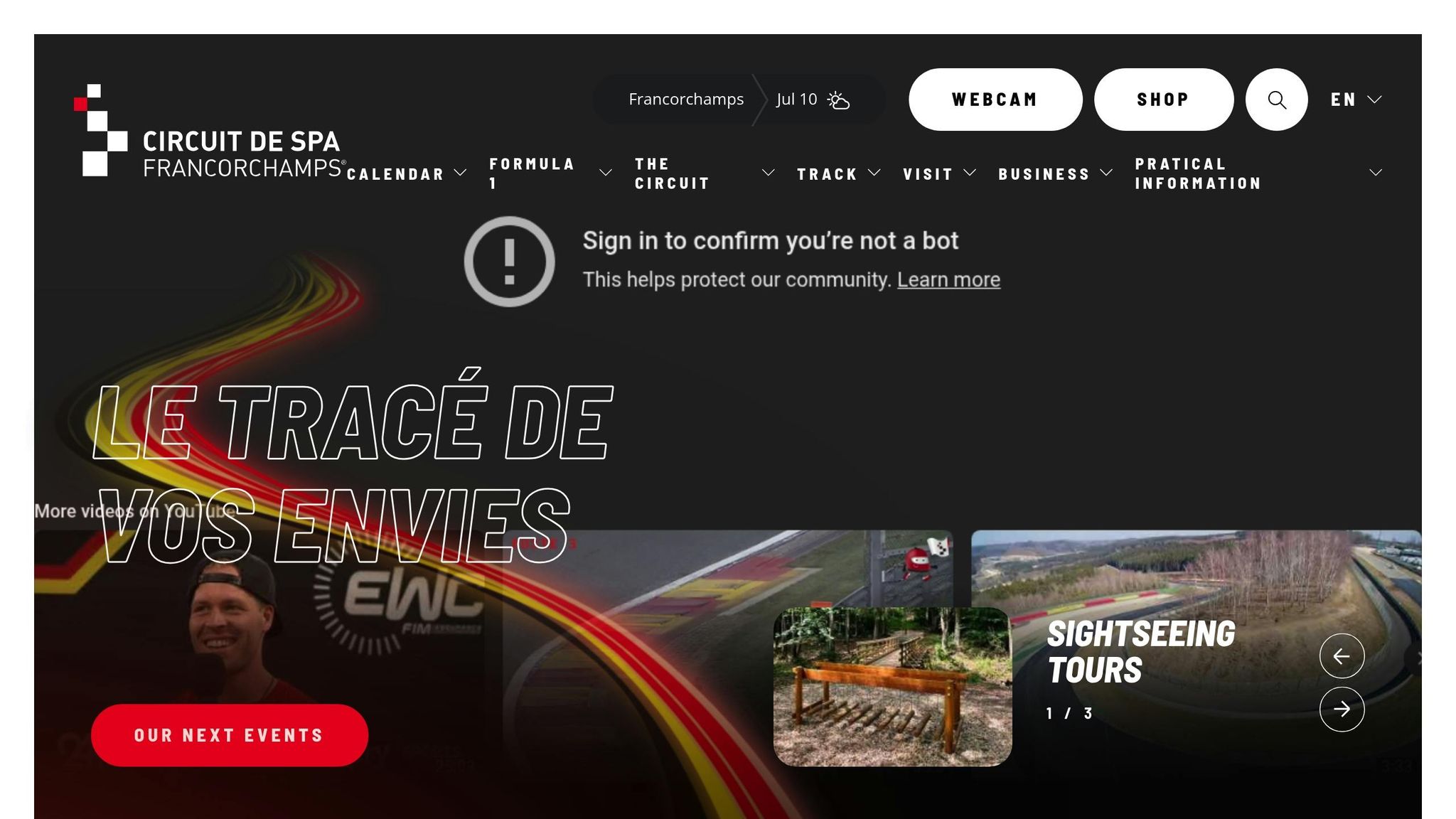
Nestled in Belgium's Ardennes region, Spa-Francorchamps is where breathtaking natural landscapes meet the adrenaline of high-speed racing. It's a circuit that demands both skill and bravery, offering a blend of beauty and edge-of-your-seat action.
Historical Significance
Spa-Francorchamps has been a cornerstone of motorsport history since hosting its first Grand Prix in 1925. Over the decades, it has become a staple on the Formula 1 calendar, hosting more than 50 Grands Prix since the World Championship began. The original track, stretching an impressive 8.7 miles (14 km) across public roads, was a grueling test for drivers and their machines. Legendary moments like Michael Schumacher's first win in 1992 and Ayrton Senna's wet-weather dominance have solidified Spa's place in racing folklore.
Track Layout Features
Spa-Francorchamps is as challenging as it is iconic. Spanning 4.352 miles (7.004 km), it holds the title of the longest circuit on the current F1 calendar. With 19 turns and a staggering 100-meter (328-foot) elevation change, it offers a unique test of skill. The Eau Rouge-Raidillon section is its crown jewel - a high-speed, uphill sequence that feels like a roller-coaster ride and demands absolute precision. To make things even trickier, Spa's microclimate is famously unpredictable. Rain might drench one section of the track while another stays dry, turning every race into a strategic puzzle.
Spectator Amenities
Spa-Francorchamps caters to fans with a variety of viewing options. Grandstands at key corners and expansive general admission areas ensure you won't miss any of the action. Shuttle services make it easier to navigate the 4.3-mile circuit, while food stalls, beverage stands, and merchandise shops keep the energy high. For those looking to stay close to the action, the circuit's camping facilities are a popular choice. Ticket prices vary, with general admission passes ranging from $150 to $300, while premium hospitality packages can exceed $1,000 for an elevated experience.
Atmosphere and Fan Experience
The atmosphere at Spa is nothing short of electrifying. Fans from across Europe and beyond gather to create a vibrant, international crowd. The roar of F1 engines reverberates through the forested hills, adding to the drama of the event. Whether you're cheering from Eau Rouge or Pouhon, you'll be in the heart of the most thrilling moments on track. Be prepared for Spa's unpredictable weather - packing rain gear and layered clothing is a must to make the most of this unforgettable experience.
5. Suzuka International Racing Course

Suzuka International Racing Course, nestled in Japan's Mie Prefecture, is a true gem in the world of motorsport. Known for its technical challenges and rich history, this legendary track has witnessed some of the most thrilling moments in Formula 1.
Historical Significance
Suzuka holds a special place in Formula 1 history, serving as the stage where 13 World Drivers' Championships were decided. Since rejoining the F1 calendar in 1987, it has been the backdrop for unforgettable battles. From Ayrton Senna's 1988 championship win to the controversial Senna-Prost collisions in 1989 and 1990, and Max Verstappen's 2022 victory, Suzuka has consistently delivered drama and excitement.
Track Layout Features
What makes Suzuka truly unique is its figure-eight design - the only one of its kind among FIA Grade 1 circuits. Stretching 5.807 km (3.608 miles) with 18 turns, the track is a test of both skill and endurance. Hans Hugenholtz, son of the track's designer John Hugenholtz, once explained:
"My father's opinion always was that a racing circuit must have a combination of different corners and challenges, so a cross-over was certainly possible."
The layout combines iconic sections like the Esses, Degner Curves, Spoon Curve, and the high-speed 130R, paired with dramatic elevation changes. It's a track that demands precision and bravery from drivers, making it one of the most challenging in motorsport.
Spectator Amenities
Suzuka doesn't just cater to drivers - it’s a haven for fans too. With a capacity of 155,000, the circuit offers plenty of viewing spots and thoughtful amenities. Food and drink prices are reasonable: water and soft drinks cost around $1.70, beers are $3.50, and meals range from $6 to $16. English commentary is available on FM86 during race weekends, ensuring international fans stay connected to the action.
Getting around the circuit is easy, thanks to three well-placed tunnels, and the main fanzone at the main gate is a hub of activity from Thursday onward. Here, fans can explore food stalls and merchandise stands, while GP Square behind the main grandstand hosts concerts and driver appearances. Three-day ticket holders enjoy extra perks, including pit lane and track access, as well as free rides on the iconic Ferris wheel, which offers stunning views of the track.
Atmosphere and Fan Experience
The energy at Suzuka is unmatched. The Japanese Grand Prix is famous for its passionate fans and vibrant atmosphere. GP Square becomes a lively gathering spot, with driver meet-and-greets and Saturday night's "Eve Festival" adding to the excitement for V1/V2 grandstand ticket holders. The circuit’s mix of cutting-edge design and breathtaking natural surroundings creates an experience best described as "a symphony of technology interwoven with the serene beauty of nature".
With multiple vantage points to catch the action and an electric vibe throughout the grounds, Suzuka is a must-visit for any motorsport enthusiast. Be sure to bring yen and wear comfortable shoes to fully enjoy everything this iconic venue has to offer.
Track Comparison Table
Dive into the details of these legendary circuits to find the racing experience that speaks to your passion. Each track brings its own mix of history, technical challenges, and fan-friendly features, offering something special for every motorsport enthusiast.
| Track | Location | Length | Capacity | Standout Features |
|---|---|---|---|---|
| Autodromo Nazionale Monza | Monza, Italy | 5.793 km (3.600 miles) | 118,865 | Famous for its long straights and high-speed corners; home to the iconic Parabolica; a historic venue since 1950 |
| Circuit de Monaco | Monte Carlo, Monaco | 3.337 km (2.074 miles) | 37,000* | Glamorous street circuit with the Casino Hairpin - the slowest corner in F1; a prestigious event since 1929 |
| Silverstone Circuit | Silverstone, UK | 5.891 km (3.660 miles) | 164,000 | Known for its fast, flowing layout on a former WWII airstrip; features the iconic Maggotts-Becketts complex; hosted the first modern F1 race in 1950 |
| Circuit de Spa-Francorchamps | Stavelot, Belgium | 7.004 km (4.352 miles) | 130,000 | The longest F1 circuit, featuring the legendary Eau Rouge-Raidillon and dramatic elevation changes |
| Suzuka International Racing Course | Suzuka, Japan | 5.807 km (3.608 miles) | 155,000 | Unique figure-eight design with the challenging 130R corner; a cornerstone of the Japanese Grand Prix since 1987 |
*Monaco's official capacity is 37,000, but race day attendance can reach up to 100,000 thanks to additional viewing spots on yachts and private balconies.
Each circuit offers a unique racing experience, shaped by its layout, history, and atmosphere. Spa-Francorchamps holds the title for the longest track at 7.004 km (4.352 miles), while Circuit de Monaco is the shortest at just 3.337 km (2.074 miles). Silverstone leads in crowd capacity, accommodating up to 164,000 fans, as seen during the 2024 British Grand Prix. On the other hand, Monaco's more intimate setting is enhanced by its extra viewing areas, allowing up to 100,000 spectators to enjoy the action.
The tracks also differ in their driving demands. Monza's high-speed straights contrast sharply with Monaco's tight, technical street layout. Meanwhile, Spa and Suzuka strike a balance, combining fast sections with challenging corners that test drivers' precision and skill.
Historically, Monza, Monaco, Silverstone, and Spa have been part of Formula 1's story since its early days, with Monza marking its 100th anniversary in 2023. Suzuka may have joined the calendar later, debuting in 1987, but it has earned its place as a fan favorite and a staple of the Japanese Grand Prix.
The corners themselves add to each track's identity. Max Verstappen once described Spa's Eau Rouge:
"It's an incredible corner. In F1 it's easy flat out nowadays but the compression you feel going through there is insane. It's definitely one of my favourite corners of the season".
This thrilling stretch contrasts with Monaco's Casino Hairpin, the slowest corner in F1, which demands a completely different approach. These unique features make every circuit a must-visit for Formula 1 fans seeking a one-of-a-kind experience.
Conclusion
These five iconic circuits each tell a story that captures the essence of Formula 1's history and speed. Monza, with its blistering straights and the roar of the passionate tifosi, embodies the heart of high-speed racing. Monaco, on the other hand, represents the glamour and exclusivity of F1, as its narrow streets challenge even the finest drivers. Silverstone, where the Formula 1 World Championship began in 1950, stands as a cornerstone of the sport's heritage, while Spa-Francorchamps thrills with its unpredictable weather and the legendary Eau Rouge corner.
Then there’s Suzuka, famous for its figure-eight layout and its role in some of the sport’s most dramatic championship battles - particularly during the unforgettable clashes between Prost and Senna. The intricate design of the track, paired with the electric energy of Japanese fans, creates an atmosphere like no other.
These circuits aren’t just places to watch races; they’re immersive experiences that connect you to the soul of Formula 1. Walking the same grounds where legends have competed, hearing the deafening roar of engines, and soaking in the unique fan cultures at each venue leave an indelible mark. The sights, sounds, and emotions of these tracks bring motorsport history to life in a way that television simply can’t replicate.
Each of these circuits weaves together the past, present, and future of Formula 1, offering something truly special to every fan. They are more than just tracks - they are the heartbeat of the sport.
FAQs
Why is the Circuit de Monaco considered the crown jewel of Formula 1?
The Circuit de Monaco: A Formula 1 Icon
The Circuit de Monaco is often hailed as the crown jewel of Formula 1, blending a rich history, unparalleled challenges, and an unmistakable air of glamour. Since its debut in 1929, the Monaco Grand Prix has stood as one of the most celebrated and historic events in motorsport.
What makes Monaco so distinctive is its tight, twisting street circuit. With sharp corners, sudden elevation changes, and the legendary tunnel, this track demands unmatched precision and skill from drivers. It’s not just about the racing, though. The event’s setting - surrounded by Monaco’s opulent yachts, world-famous casinos, and a star-studded crowd - adds a layer of sophistication and excitement that few other races can rival. It’s an experience that captivates everyone involved, from drivers to fans.
What makes Spa-Francorchamps one of the most challenging and iconic F1 circuits?
Spa-Francorchamps stands out as a track that blends historical importance, technical challenges, and stunning natural scenery. Built back in 1921 and modified over the years to prioritize safety, the circuit’s location in the Ardennes forest offers dramatic elevation shifts and a layout that pushes both drivers and their machines to the edge.
This legendary track is home to iconic sections like Eau Rouge and Raidillon, where drivers need a mix of precision and sheer courage, and the Kemmel Straight, which emphasizes the importance of aerodynamics and tire management at high speeds. Adding to the challenge, Spa’s famously unpredictable weather often creates a scenario where one part of the track is soaked with rain while another remains dry. This unique characteristic tests every F1 driver’s skill and ability to adapt under ever-changing conditions.
What makes Suzuka International Racing Course such an iconic venue for deciding Formula 1 championships?
Suzuka International Racing Course: A Formula 1 Icon
The Suzuka International Racing Course holds a special place in Formula 1, thanks to its storied history and unforgettable championship moments. What sets Suzuka apart is its unique figure-eight layout, blending high-speed straights with some of the most technically challenging corners in motorsport. This design pushes drivers to their limits, making it one of the most demanding circuits on the calendar.
Over the years, Suzuka has witnessed some of the sport's most dramatic title-deciding battles. One of the most famous was the controversial 1989 clash between Ayrton Senna and Alain Prost, a moment that forever altered the championship narrative and became a defining chapter in F1 history.
Typically held as the season's final or penultimate race, Suzuka offers an electric atmosphere fueled by its passionate fans. The combination of its technical complexity, rich history, and the sheer excitement of race day solidifies Suzuka as a bucket-list destination for any Formula 1 fan.
Related posts
- Monaco Grand Prix Circuit Guide: The Prestige, Precision, and Pressure of F1’s Crown Jewel
- Suzuka’s Legacy: How Japan’s Iconic Figure-8 Circuit Became a Driver Favourite
- Spa-Francorchamps Deep Dive: The Drama, Danger, and DNA of Belgium’s Legendary Track
- How F1 Tracks are Designed: The Art and Science Behind the Curves

